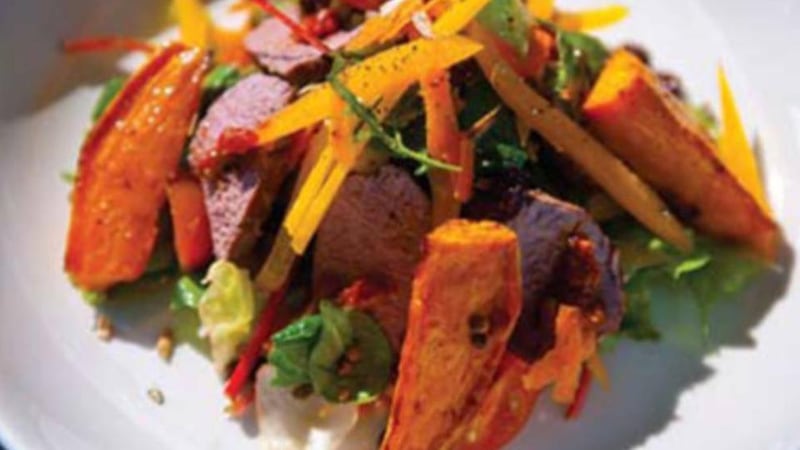We have two inevitable companions in life – “choice” and “change”. The food choices we continually make, add up. A certain eating pattern can help reduce the risk of developing high blood pressure. It can also lower your blood pressure if it’s already too high.
Prioritising what dietary habit you most want to change is important when there are a significant number to be made. Some succeed in enjoying a favourite food, but look for healthier ways of preparing and cooking it. Others might simply reduce the portion size or eat a food less frequently.
If your blood pressure is high, your changes might include eating less processed food with added salt, drinking alcohol in moderation, making time to exercise, quitting smoking and perhaps losing weight.

The evidenced-based Dash diet (Dietary Approaches to Stop Hypertension) focuses on reducing blood pressure by eating meals that are low in saturated fat, and high in fruits and vegetables, and that contain moderate amounts of low-fat dairy.
The Dash eating plan includes whole grains, poultry, fish and nuts, and has less saturated fat, red and processed meat, desserts and sugary drinks.
It is higher in potassium, calcium and fibre because of the strong emphasis on eating three low-fat dairy servings and up to nine servings of fruit and vegetables. Eating less salt is also a fundamental part of reducing blood pressure.
Too much salt can cause fluid retention, which increases blood pressure and risk of stroke. The more salt we eat in food, the more we develop a taste for it.
The average daily salt intake in Ireland is high – about 10g in adults. That is about a dessertspoon in size. Although we need some salt in our diets, this intake is well in excess of what we need.
The short-term target is to reduce our salt intake to 6g per day. The target for children is 3g day. That’s why you won’t see any table salt in the recipes below.
Shaking the salt habit:
Add little or no salt when cooking. Avoid adding salt to water when cooking rice, pasta or potatoes – no matter what the pack says. Learn to adapt recipes and flavour food instead with black pepper, herbs, garlic, spices or lemon juice.
Have the black pepper grinder on the table only – no salt.
When shopping, avoid the obvious highly salty foods such as crisps, popcorn, salted nuts, anchovies, smoked fish, bacon/other processed meats and ready meals.
Salt is also found in some cheeses, soups and sauces, and even in some foods in which you may not expect to find salt – bread, breakfast cereal and even biscuits. Read labels.
Buy lower-salt versions of stock cubes and seasonings like soya and Worcester sauce.
Choose no-added salt or lower-salt versions of tinned foods such as sweet corn and baked beans. Buy tuna or salmon canned in olive oil or spring water rather than brine.
If you're trying to lose weight, you can still use the principles of the Dash eating plan, but follow it at a lower calorie level. Losing even 5-10 per cent of your weight can lower your blood pressure. A good way to change to the Dash eating plan is to keep a diary of your current eating habits.
Write down what you eat, how much, when and why. Note your snacks throughout the day or if you skip breakfast and eat a low-fibre, high-fat lunch. Do this for several days. You’ll be able to see where you can start making changes.
Enjoying red meat in smaller quantities and with fuller flavours is possible too. I particularly like the lamb recipe as it not only taste good, but the portion of red meat is just right. Enjoy.
Oriental chicken and vegetable stir fry
Dunbrody House
Serves 2
Oriental Chicken
2 medium-sized chicken breasts – skinless
Red chilli
2 cloves garlic
1 inch root ginger
Grated zest of ½ lime
Pinch cayenne pepper
1 tablespoon olive oil
Vegetable Stir Fry
½ red chilli – diced
½ inch root ginger – peeled and chopped
½ green pepper – sliced
2oz/50g mange tout
2oz/50g green beans
2oz/50g broccoli – broken into spears
1 tablespoon water
Begin by marinating the chicken breasts.
Finely dice the chilli, garlic and ginger and add it to a small bowl with the lime juice, cayenne pepper and olive oil. Mix well until thoroughly combined.
Meanwhile, take the chicken breast and, using a sharp knife, make two or three incisions in the breast to allow the marinate to penetrate through. Put the chicken breast in the marinade and leave for anything from 20 minutes to three hours.
Preheat the oven to 190C/375F/Gas Mark 5. Heat a pan with a little oil and place the chicken breasts onto the pan and brown off on both sides for 2-3 minutes and then transfer to a small baking tray and pop them into the preheated oven for 12-15 minutes or until they are cooked through.
Reheat the pan on which you cooked the chicken, add the diced chilli and ginger and cook for 2-3 minutes. Next, add the green peppers, broccoli, mange tout and green beans and cook for a further 4-5 minutes. If necessary, add in the water during the cooking process to stop the vegetables from burning. Serve the vegetables on a large serving platter with the chicken breast on top. Garnish with a sprig of coriander.
Roast spiced sweet potato and lamb salad with a lemon and mixed seed dressing
Just Cooking, Firies, Kerry
Serves 4
2 tbsp rapeseed oil
250g sweet potatoes, peeled and cut into wedges
2 tsp Thai red curry or harissa paste
1 tbsp coriander seeds, coarsely crushed
1 large carrot, peeled and grated
1 red onion, peeled and finely sliced
1 packet of cherry tomatoes
250g mixed salad leaves
1 yellow pepper, de-seeded and cut into fine strips
1 celery stick, peeled and finely sliced
25g sultanas
200g lamb loin, trimmed of all fat
2 tbsp rapeseed oil for cooking the lamb
Preheat the oven to gas mark 6/200C/fan 180c. Place the potato wedges in a bowl with the Thai curry paste, coriander seeds and rape seed oil. Toss well so that the potatoes are covered with the oil. Place on a baking tray and cook in the oven until tender (about 20-25 minutes).
Heat a pan over a medium heat and add a little rapeseed oil. When the pan is hot, place the lamb in the pan and brown on all sides. Remove the lamb from the pan and place on a baking sheet. Cook to the desired degree – as a guide, medium: about 8 minutes; and well done: about 15 minutes. When cooked, remove from the oven and allow to rest for 3-4 minutes.
Once the potatoes are cooked, place all of the other ingredients in a large bowl and dress with a little of the dressing.
Place the salad in bowls and top with the sweet potato. Slice the lamb and place over the dressed salad.
Dressing
Serves 4
50ml rapeseed oil
1 tbsp white wine vinegar
Pepper
4 tbsp mixed seeds
2 tbsp clear honey
1 tbsp lemon juice
Whisk the vinegar, lemon juice and pepper together. Whisk in the rapeseed oil slowly. Dry fry the seeds in a frying pan and then grind in a mortar and pestle. Add the seeds to the dressing.
Paula Mee is lead dietitian at Medfit Proactive Healthcare and a member of the Irish Nutrition and Dietetic Institute. pmee@medfit.ie









